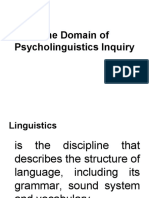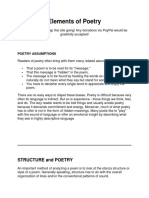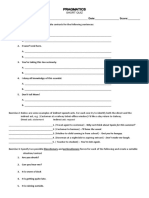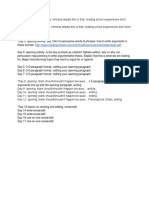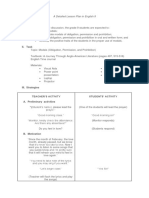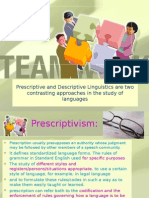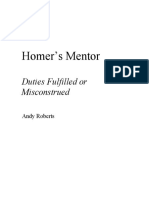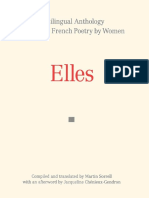0 ratings0% found this document useful (0 votes)
647 viewsTopic Sentence
Topic Sentence
Uploaded by
rotsacreijav666666The document discusses topic sentences and their role and structure within paragraphs. It begins by defining a topic sentence as a statement that expresses the main point of a paragraph and serves as a guide for readers. It then discusses where topic sentences are typically placed, noting they usually begin paragraphs but can also be delayed or end paragraphs in some cases. The document provides guidance on developing effective topic sentences, emphasizing they should clearly express the limited topic or main idea of the paragraph and contribute to the overall argument. It also notes not every paragraph requires a topic sentence if redundancy would occur.
Copyright:
© All Rights Reserved
Available Formats
Download as DOCX, PDF, TXT or read online from Scribd
Topic Sentence
Topic Sentence
Uploaded by
rotsacreijav6666660 ratings0% found this document useful (0 votes)
647 views6 pagesThe document discusses topic sentences and their role and structure within paragraphs. It begins by defining a topic sentence as a statement that expresses the main point of a paragraph and serves as a guide for readers. It then discusses where topic sentences are typically placed, noting they usually begin paragraphs but can also be delayed or end paragraphs in some cases. The document provides guidance on developing effective topic sentences, emphasizing they should clearly express the limited topic or main idea of the paragraph and contribute to the overall argument. It also notes not every paragraph requires a topic sentence if redundancy would occur.
Original Description:
D
Copyright
© © All Rights Reserved
Available Formats
DOCX, PDF, TXT or read online from Scribd
Share this document
Did you find this document useful?
Is this content inappropriate?
The document discusses topic sentences and their role and structure within paragraphs. It begins by defining a topic sentence as a statement that expresses the main point of a paragraph and serves as a guide for readers. It then discusses where topic sentences are typically placed, noting they usually begin paragraphs but can also be delayed or end paragraphs in some cases. The document provides guidance on developing effective topic sentences, emphasizing they should clearly express the limited topic or main idea of the paragraph and contribute to the overall argument. It also notes not every paragraph requires a topic sentence if redundancy would occur.
Copyright:
© All Rights Reserved
Available Formats
Download as DOCX, PDF, TXT or read online from Scribd
Download as docx, pdf, or txt
0 ratings0% found this document useful (0 votes)
647 views6 pagesTopic Sentence
Topic Sentence
Uploaded by
rotsacreijav666666The document discusses topic sentences and their role and structure within paragraphs. It begins by defining a topic sentence as a statement that expresses the main point of a paragraph and serves as a guide for readers. It then discusses where topic sentences are typically placed, noting they usually begin paragraphs but can also be delayed or end paragraphs in some cases. The document provides guidance on developing effective topic sentences, emphasizing they should clearly express the limited topic or main idea of the paragraph and contribute to the overall argument. It also notes not every paragraph requires a topic sentence if redundancy would occur.
Copyright:
© All Rights Reserved
Available Formats
Download as DOCX, PDF, TXT or read online from Scribd
Download as docx, pdf, or txt
You are on page 1of 6
At a glance
Powered by AI
A topic sentence states the main point of a paragraph and usually appears at the beginning. It helps guide the reader through the argument and makes it easier for the writer to organize their ideas.
A topic sentence states the main point of a paragraph. It usually appears at the beginning of a paragraph, but can sometimes be delayed. It serves as a 'signpost' to alert readers to the most important points.
Some techniques for coming up with effective topic sentences include focusing on one key idea, using concrete examples, and considering different angles to approach the topic. Transitional sentences can also be used to introduce the topic sentence.
Topic Sentence
What is a topic sentence?
A topic sentence states the main point of a paragraph: it serves as a mini-thesis for the paragraph. You
might think of it as a signpost for your readersor a headlinesomething that alerts them to the most
important, interpretive points in your essay. When read in sequence, your essay's topic sentences will
provide a sketch of the essay's argument. Thus topics sentences help protect your readers from confusion
by guiding them through the argument. But topic sentences can also help you to improve your essay by
making it easier for you to recognize gaps or weaknesses in your argument.
Where do topic sentences go?
Topic sentences usually appear at the very beginning of paragraphs. In the following example
from Anatomy of Criticism, Northrop Frye establishes the figure of the tragic hero as someone more than
human, but less than divine. He backs up his claim with examples of characters from literature, religion
and mythology whose tragic stature is a function of their ability to mediate between their fellow human
beings and a power that transcends the merely human:
The tragic hero is typically on top of the wheel of fortune, half-way between human society
on the ground and the something greater in the sky. Prometheus, Adam, and Christ hang between
heaven and earth, between a world of paradisal freedom and a world of bondage. Tragic heroes are so
much the highest points in their human landscape that they seem the inevitable conductors of the power
about them, great trees more likely to be struck by lightning than a clump of grass. Conductors may of
course be instruments as well as victims of the divine lightning: Milton's Samson destroys the Philistine
temple with himself, and Hamlet nearly exterminates the Danish court in his own fall.
The structure of Frye's paragraph is simple yet powerful: the topic sentence makes an abstract point, and
the rest of the paragraph elaborates on that point using concrete examples as evidence.
Does a topic sentence have to be at the beginning of a paragraph?
No, though this is usually the most logical place for it. Sometimes a transitional sentence or two will come
before a topic sentence:
We found in comedy that the term bomolochos or buffoon need not be restricted to farce, but could
be extended to cover comic characters who are primarily entertainers, with the function of increasing or
focusing the comic mood. The corresponding contrasting type is the suppliant, the character, often
female, who presents a picture of unmitigated helplessness and destitution. Such a figure is
pathetic, and pathos, though it seems a gentler and more relaxed mood than tragedy, is even more
terrifying. Its basis is the exclusion of an individual from the group; hence it attacks the deepest fear in
ourselves that we possessa fear much deeper than the relatively cosy and sociable bogey of hell. In the
suppliant pity and terror are brought to the highest possible pitch of intensity, and the awful consequences
of rejecting the suppliant for all concerned is a central theme of Greek tragedy.
The context for this passage is an extended discussion of the characteristics of tragedy. In this paragraph,
Frye begins by drawing a parallel between the figure of the buffoon in comedy and that of the suppliant in
tragedy. His discussion of the buffoon occurred in a earlier section of the chapter, a section devoted to
comedy. The first sentence of the current paragraph is transitional: it prepares the way for the topic
sentence. The delayed topic sentence contributes to the coherence of Frye's discussion by drawing an
explicit connection between key ideas in the book. In essays, the connection is usually between the last
paragraph and the current one.
Sometimes writers save a topic sentence for the end of a paragraph. You may, for example, occasionally
find that giving away your point at the beginning of a paragraph does not allow you to build your
argument toward an effective climax.
How do I come up with a topic sentence? And what makes a good
one?
Ask yourself what's going on in your paragraph. Why have you chosen to include the information you
have? Why is the paragraph important in the context of your argument? What point are you trying to
make?
Relating your topic sentences to your thesis can help strengthen the coherence of your essay. If you
include a thesis statement in your introduction, then think of incorporating a keyword from that
statement into the topic sentence. But you need not be overly explicit when you echo the thesis statement.
Better to be subtle rather than heavy-handed. Do not forget that your topic sentence should do more than
just establish a connection between your paragraph and your thesis. Use a topic sentence to show how
your paragraph contributes to the development of your argument by moving it that one extra step
forward. If your topic sentence merely restates your thesis, then either your paragraph is redundant or
your topic sentence needs to be reformulated. If several of your topic sentences restate your thesis, even if
they do so in different words, then your essay is probably repetitive.
Does every paragraph need one?
No, but most do. Sometimes a paragraph helps to develop the same point as in the previous paragraph,
and so a new topic sentence would be redundant. And sometimes the evidence in your paragraph makes
your point so effectively that your topic sentence can remain implicit. But if you are in doubt, it's best to
use one.
Techniques for Writing: Writing Topic Sentences for
Paragraphs
A paragraph is a sequence of sentences that cooperate in supporting one main point.
Sometimes that point is so obvious that it doesn't need to be stated, but often a
paragraph begins with a topic sentence that states the main point directly. Before you
can write a topic sentence, you must decide what you want to say and what you don't
want to say in your paragraph. In other words, you must first explore your starting
topic and then select your limited topic. The next step is to make a statement about the
limited topic. Keep these points in mind:
1. A starting topic is usually broad, stimulating many ideas.
2. A limited topic is narrow, connecting a few selected ideas.
3. A topic sentence makes a statement about the limited topic.
For example, study this progression:
Starting topic: Football
Limited topic: The role that football has played in my education
Topic sentence: If it hadn't been for football, I might never have
taken school seriously.
Note: A topic sentence is always a complete sentence expressing an idea about the
limited topic. It is not a title (What football means to me), or an explanation of the
writer's plan (I am going to tell you about the role football played in my education.)
The more clearly it focuses the reader's attention on the points covered by the
paragraph that the writer wants to make, the better.
Exercise A: For each limited topic below, select the two items that could serve as
topic sentences.
Limited topic: how to train a cat.
1. This paragraph is about how to train a cat.
2. Before a cat learns anything, it first teaches its owner a lesson in
humility.
3. Everything you wouldn't have thought to ask about training a cat.
4. Training a cat takes physical stamina.
5. Animal training is a complicated subject.
Limited topic: changes in patients as they settle into convalescent homes
1. Americans are learning how to grow old gracefully.
2. The outside world seems to shrink when seen through the window
of a convalescent home.
3. Closing up a home and moving to a small room can make even an
extrovert turn inward.
4. It is important to look at the changes in patients' attitudes as they
settle into convalescent homes.
5. The increasing delight in daily conversation as patients become
accustomed to life in a convalescent home.
Limited topic: scuba diving
1. The excitement of scuba diving.
2. My childhood fascination with scuba diving.
3. It is very interesting to experience scuba diving.
4. The sport of scuba diving has always excited me.
5. Since I was a child, I've been fascinated by scuba diving.
Notice that choosing a topic sentence helps to focus the topic still further. Using the
same cluster of ideas, the student writing about the role football played in his
education could have chosen one of these several topic sentences instead:
a. My high school football coach transformed a sport into a powerful
mental discipline.
b. The lessons I learned from playing high school football prepared
me for the challenges of college.
c. If it hadn't been for football, I might never have taken school
seriously.
Each sentence declares a slightly different role that football played in this student's
education and alerts the reader to a different focus in the paragraph. Therefore, the
topic sentence acts as a tool for organizing the rest of the paragraph.
Exercise B: Below are three sets of notes for developing the topic, the role football
played in my education. For each one, select which topic sentence will fit the
completed paragraph. Choose a, b, or c from the list above.
1. concentration to learn plays
discipline to follow through
flexibility when plan fails
college classes painful at first
college pressure like my JV year in HS
2. distractions from high schoolsocial life, job, being cool
best friends dropped out
team solidarity, support, tutoring
State Championship goal, whole school cared
coach insisted on better than C average
3. coach's weird warm-up exercises
visualizing ways to overcome hardship
insistence on accuracy
team meditations
application of problem-solving tricks in daily life
You might also like
- CHECKED Lesson Plan On The Wise Old Woman and Misplaced ModifiersDocument12 pagesCHECKED Lesson Plan On The Wise Old Woman and Misplaced ModifiersLancy Abegail Gabrillo CastronuevoNo ratings yet
- Call of The Wild by Jack LondonDocument40 pagesCall of The Wild by Jack LondonLisa WardNo ratings yet
- Works of Rizal While in USTDocument9 pagesWorks of Rizal While in USTKarlo Antonio100% (2)
- Year 10 Lesson Plans - Persuasive Speeches 10 JuneDocument2 pagesYear 10 Lesson Plans - Persuasive Speeches 10 JuneRochelle ColemanNo ratings yet
- Analysis of The Silent CoupleDocument1 pageAnalysis of The Silent CoupleZobia Asif100% (1)
- The Domain of Psycholinguistics InquiryDocument34 pagesThe Domain of Psycholinguistics InquiryRogel BelvestreNo ratings yet
- Differentiated LessonDocument3 pagesDifferentiated Lessonlindsay_115No ratings yet
- 25 Moral DilemmasDocument13 pages25 Moral Dilemmasrotsacreijav666666No ratings yet
- David SalonDocument5 pagesDavid Salonrotsacreijav6666660% (1)
- 25 Moral DilemmasDocument13 pages25 Moral Dilemmasrotsacreijav666666No ratings yet
- Deductive Lesson Plan in EnglishDocument4 pagesDeductive Lesson Plan in Englishrotsacreijav666666100% (2)
- Cloud PicturesDocument11 pagesCloud PicturesKanchukee Kumar100% (3)
- Divisions of LiteratureDocument42 pagesDivisions of LiteratureLiza D. MataNo ratings yet
- Lesson Plan SpeechDocument4 pagesLesson Plan SpeechErwan OtnawreNo ratings yet
- Types of Discourse WorksheetDocument3 pagesTypes of Discourse WorksheetJili RusNo ratings yet
- Elements of PoetryDocument7 pagesElements of PoetrycjNo ratings yet
- Reader-Response StylisticsDocument2 pagesReader-Response StylisticsWilson EjercitoNo ratings yet
- Sentence Correction RulesDocument10 pagesSentence Correction RulesNimra FirdousNo ratings yet
- The World Is An AppleDocument2 pagesThe World Is An AppleJohn AmbasNo ratings yet
- The Effectiveness of Grammar TranslationDocument5 pagesThe Effectiveness of Grammar Translationsili sola100% (1)
- Summative #1 For 1st Quarter English 7Document2 pagesSummative #1 For 1st Quarter English 7Alona Maurice OlivanNo ratings yet
- Types of Speech StyleDocument16 pagesTypes of Speech StylecassNo ratings yet
- Difference Between Prose and PoetryDocument3 pagesDifference Between Prose and PoetryMae Arra Gilbao Lecobu-anNo ratings yet
- Topic SentencesDocument2 pagesTopic Sentencesសារុន កែវវរលក្ខណ៍No ratings yet
- Faulty Logic WorksheetDocument1 pageFaulty Logic WorksheetKimberley Sicat BautistaNo ratings yet
- Argument by Emotive LanguageDocument6 pagesArgument by Emotive LanguageRcl ClaireNo ratings yet
- Katelyn Donath - Practice Using Transition WordsDocument2 pagesKatelyn Donath - Practice Using Transition WordskatelynNo ratings yet
- Instructional Plan in English 9 INSETDocument4 pagesInstructional Plan in English 9 INSETGlenmae LegaspiNo ratings yet
- Monologue and DialogueDocument4 pagesMonologue and DialogueLina KetfiNo ratings yet
- SemanticsDocument21 pagesSemanticsHana BiščevićNo ratings yet
- Literary Devices: Literary Elements & Literary TechniquesDocument10 pagesLiterary Devices: Literary Elements & Literary TechniquesAnie Grace Garcia100% (1)
- Pragmatics - Short QuizDocument2 pagesPragmatics - Short QuizMarianne ChristieNo ratings yet
- Argumentative Essay Lesson PlanDocument4 pagesArgumentative Essay Lesson PlanJacob Walse-DominguezNo ratings yet
- Cohesive Devices: Group Members: Muhammad Farid Akmal Bin Adam Siti Saidah Binti Abd Rahman Vicneswary A/P PurshotamanDocument9 pagesCohesive Devices: Group Members: Muhammad Farid Akmal Bin Adam Siti Saidah Binti Abd Rahman Vicneswary A/P PurshotamanSiti Saidah100% (1)
- 3rd&4th Quarter Grade 8Document16 pages3rd&4th Quarter Grade 8Shyr R PalmNo ratings yet
- Morphological Structure of Neologisms During The Covid-19 PandemicDocument17 pagesMorphological Structure of Neologisms During The Covid-19 PandemicPsychology and Education: A Multidisciplinary JournalNo ratings yet
- Modals ApplyDocument10 pagesModals ApplyArvieDeMesaLopezNo ratings yet
- ExemplificationDocument2 pagesExemplificationErnie AstoetieNo ratings yet
- Active Passive Voice AssignmentDocument6 pagesActive Passive Voice Assignmenthero zamruddynNo ratings yet
- Morphology WorksheetDocument6 pagesMorphology WorksheetRaze PerezNo ratings yet
- Informative Writing RubricDocument2 pagesInformative Writing Rubricapi-533624966No ratings yet
- Prepositions List and ExamplesDocument4 pagesPrepositions List and ExamplesDannySmith4975No ratings yet
- Descriptive and Prescriptive For HS LevelDocument20 pagesDescriptive and Prescriptive For HS LevelKasturiRajagopalNo ratings yet
- What Does Teaching Pronunciation InvolvesDocument3 pagesWhat Does Teaching Pronunciation InvolveskokondosNo ratings yet
- Reading and Writing: Performance Task-MidtermDocument2 pagesReading and Writing: Performance Task-MidtermChristian BlantucasNo ratings yet
- Generative LinguisticsDocument16 pagesGenerative LinguisticsAli ShimmeriNo ratings yet
- Active Passive VoiceDocument6 pagesActive Passive VoiceDina ValdezNo ratings yet
- Rubric For Memorized SpeechDocument1 pageRubric For Memorized SpeechBiana QtyNo ratings yet
- Lp-Because I Could Not Stop For DeathDocument3 pagesLp-Because I Could Not Stop For DeathMarco KalaloNo ratings yet
- Conjunctive Adverbs & Parenthetical Expressions (Discussion)Document2 pagesConjunctive Adverbs & Parenthetical Expressions (Discussion)Excellent Quality Services0% (1)
- JargonDocument14 pagesJargonNick CruzNo ratings yet
- Basic English To Business EnglishDocument4 pagesBasic English To Business EnglishGlad MacNo ratings yet
- PunsDocument7 pagesPunsapi-270020534No ratings yet
- A Detailed Lesson Plan in English 7 - DemoDocument13 pagesA Detailed Lesson Plan in English 7 - DemoNiña Romina G. NavaltaNo ratings yet
- Documentation StylesDocument25 pagesDocumentation StylesErnest Gerard Baiño DuranoNo ratings yet
- Revision Sheet 3 (The Matsuyama Mirror & The War of The Worlds)Document4 pagesRevision Sheet 3 (The Matsuyama Mirror & The War of The Worlds)ghada kamalNo ratings yet
- Precis WritingDocument13 pagesPrecis WritingAyeshaNo ratings yet
- DLL English 10 Q1 - Module 1 - Lesson 2 - Reflection, The Gorgon's HeadDocument9 pagesDLL English 10 Q1 - Module 1 - Lesson 2 - Reflection, The Gorgon's HeadJennifer OestarNo ratings yet
- Verbal ParticipleDocument3 pagesVerbal ParticipleAlyanna JovidoNo ratings yet
- The Nature of LanguageDocument3 pagesThe Nature of LanguageSheila Mae Paltep100% (1)
- Demonstrating Semantic Knowledge PresentationDocument31 pagesDemonstrating Semantic Knowledge PresentationDee Doicela100% (2)
- World Englishes EssayDocument11 pagesWorld Englishes EssayEmad MokhtarNo ratings yet
- Transitional WordsDocument38 pagesTransitional Wordsjho_olis67% (3)
- 21 STDocument7 pages21 STMika Dato ValdezNo ratings yet
- WEEK 7 DIRECT and Reported SpeechDocument6 pagesWEEK 7 DIRECT and Reported SpeechTrixia100% (1)
- 4 Essay Organization and Structure-1Document5 pages4 Essay Organization and Structure-1Summaira ParveenNo ratings yet
- How To Write An EssayDocument5 pagesHow To Write An EssayALCIBAR YUCCHANo ratings yet
- How To Kit: Puppet-MakingDocument29 pagesHow To Kit: Puppet-Makingrotsacreijav666666No ratings yet
- Chips Chin ChickDocument6 pagesChips Chin Chickrotsacreijav666666No ratings yet
- Answer The Questions About The Information Given in This News ItemDocument10 pagesAnswer The Questions About The Information Given in This News Itemrotsacreijav666666No ratings yet
- I Am Writing in Order To Apply For The Teacher in Charge PositionDocument1 pageI Am Writing in Order To Apply For The Teacher in Charge Positionrotsacreijav666666No ratings yet
- CSA Teen On BullyDocument7 pagesCSA Teen On Bullyrotsacreijav666666No ratings yet
- Values Project Joan MotaDocument53 pagesValues Project Joan Motarotsacreijav666666No ratings yet
- First DraftDocument4 pagesFirst Draftrotsacreijav666666No ratings yet
- I Am Writing in Order To Apply For The Teacher in Charge PositionDocument1 pageI Am Writing in Order To Apply For The Teacher in Charge Positionrotsacreijav666666No ratings yet
- Chinese Parable of The Lost AxeDocument8 pagesChinese Parable of The Lost Axerotsacreijav666666No ratings yet
- First DraftDocument1 pageFirst Draftrotsacreijav666666No ratings yet
- Lesson Plan Unit 9 - Problem SolvingDocument3 pagesLesson Plan Unit 9 - Problem Solvingrotsacreijav666666No ratings yet
- A House, A HomeDocument3 pagesA House, A HomeantkaurNo ratings yet
- Semi-Detailed Lesson Plan in English 10Document13 pagesSemi-Detailed Lesson Plan in English 10Anonymous PPzzfDZkLINo ratings yet
- The Unrequited Love in The Poesy of K. LagundaDocument48 pagesThe Unrequited Love in The Poesy of K. LagundaMICHELLE DIALOGONo ratings yet
- Roberts, Andy (1999) - Homer's Mentor PDFDocument8 pagesRoberts, Andy (1999) - Homer's Mentor PDFLorenz49No ratings yet
- Contemporary ResearchDocument7 pagesContemporary ResearchPauNo ratings yet
- Martin Travers Auth. Thomas MannDocument155 pagesMartin Travers Auth. Thomas MannCadu OrtolanNo ratings yet
- English First Peoples 10 First Nations Poetry Examples With Questions and Finding Poetic DevicesDocument4 pagesEnglish First Peoples 10 First Nations Poetry Examples With Questions and Finding Poetic DevicesMaura MelgarejoNo ratings yet
- Russian Literature XLIV (1998) 331-345 North-HollandDocument15 pagesRussian Literature XLIV (1998) 331-345 North-HollandmoonwhiteNo ratings yet
- Asean - Finals ReviewerDocument7 pagesAsean - Finals ReviewerAshley Gwyneth MortelNo ratings yet
- 12 English Core Notes FlamingoDocument58 pages12 English Core Notes FlamingoPʌŋĸʌj VɘʀɱʌNo ratings yet
- TOEFLDocument6 pagesTOEFLSekar InnayahNo ratings yet
- Bacon As SN EssayistDocument3 pagesBacon As SN EssayistUsmanHaider0% (1)
- IngleseDocument6 pagesInglesesmataloneNo ratings yet
- All in The Golden Afternoon: Alice's Adventures in Wonderland Reading QuestionsDocument13 pagesAll in The Golden Afternoon: Alice's Adventures in Wonderland Reading QuestionsSALLY HANKINNo ratings yet
- When We Read Gangadhar MeherDocument3 pagesWhen We Read Gangadhar MeherRajendra PadhiNo ratings yet
- (Exeter Textes Litteraires) Martin Sorrell-Elles - A Bilingual Anthology of Modern French Poetry by Women-University of Exeter Press (1995)Document269 pages(Exeter Textes Litteraires) Martin Sorrell-Elles - A Bilingual Anthology of Modern French Poetry by Women-University of Exeter Press (1995)Filip Ionescu100% (1)
- An Essay of The Lord of The RingsDocument6 pagesAn Essay of The Lord of The RingsLord HawreghiNo ratings yet
- Instructor - Songwriting Notebook 2Document33 pagesInstructor - Songwriting Notebook 2rcpretoriusNo ratings yet
- 21st RevDocument5 pages21st RevEdelyn Curioso100% (1)
- Commentary On The Prophet AmosDocument27 pagesCommentary On The Prophet AmosDim Bulb100% (2)
- Apah Suktam (Rig Veda 10.9) - in Sanskrit With Meaning and VideoDocument7 pagesApah Suktam (Rig Veda 10.9) - in Sanskrit With Meaning and VideojabroloNo ratings yet
- In MemoriamDocument5 pagesIn MemoriamDaniel I. DutraNo ratings yet
- Books & Authors - SSC CGLDocument22 pagesBooks & Authors - SSC CGLrazaNo ratings yet
- The Clown PunkDocument1 pageThe Clown Punkraab1No ratings yet
- Nadela Act7 PDFDocument10 pagesNadela Act7 PDFDOROTHY JOY NADELANo ratings yet
- RilkeDocument119 pagesRilkeRebwar Qaremani100% (11)
- Detailed Lesson Plan in English For Grade 9Document7 pagesDetailed Lesson Plan in English For Grade 9PASACAS, MARY ROSE P.No ratings yet





